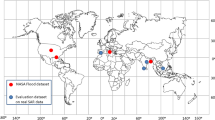Abstract
Natural disasters such as flood, tsunami, earthquake and cyclones usually influence the microspaces and in urban areas, thereby causing the problem to rescuers to make way to the victims. Rescue operations in these situations are also hampered due to darkness caused by power cut and unavailability of other light sources to rescue people in peril or to even carry out evacuation operations. Therefore, we need solution to map all the essential large-scale feature spaces in dark to avail safety and saving numerous lives in disaster environments. This study presents a soft framework for crisis mapping in dark to map aerial view of geo-specific terrain in disaster struck areas so that effective map of debris and localization of victims can be achieved to enable strategic planning of rescue operations.





Similar content being viewed by others
References
Charpiat, G., Hofmann, M., & Schölkopf, B. (2008). Automatic image colorization via multimodal predictions. In D. Forsyth, P. Torr, & A. Zisserman (Eds.) Proceedings of the European conference on computer vision (pp. 126–139). Marseille: Springer.
Cheng, Z., Yang, Q., & Sheng, B. (2015) “Deep colorization, (2015)”. In Proceedings of the international conference on computer vision.
Deshpande, R. J., & Forsyth, D. (2015). Learning large-scale automatic image colorization. In Proceedings of the international conference on computer vision.
Iizuka, S., Simo-Serra, E., & Ishikawa, H. (2016). Let there be color!: Joint end-to-end learning of global and local image priors for automatic image colorization with simultaneous classification. In Proceedings of ACM SIGGRAPH (Vol. 35, no. 4).
Laffont, P. Y., Ren, Z., Tao, X., Qian, C., & Hays, J. (2014). Transient attributes for high-level understanding and editing of outdoor scenes. ACM Transactions on Graphics, 33(4).
Larsson, G., Maire, M., & Shakhnarovich, G. (2016). Learning representations for automatic colorization. Tech. Rep. arXiv: 1603.06668.
Levin, L. D., & Weiss, Y. (2004). Colorization using optimization. ACM Transactions on Graphics, 23(3), 689–694.
Patterson, G., & Hays, J. (2012). Sun attribute database: Discovering, annotating, and recognizing scene attributes. In Proceedings of the conference on computer vision and pattern recognition.
Pitié, F., & Kokaram, A. (2007). The linear Monge-Kantorovitch linear color mapping for example-based color transfer. In European conference on visual media production.
Rai, (2014). Attribute based level adaptive thresholding algorithm for object extraction. Journal of Advancement in Robotics, 1(1), 2014.
Rai, A. (2015). A novel decomposable pixel component analysis algorithm for automating multispectral satellite image denoising. Research & Reviews: Journal of Embedded System & Applications, 2(3), 18–25.
Rai, R., & Kannan, J. (2018). Differed restructuring of neural connectome using evolutionary neurodynamic algorithm for improved M2M online learning. Procedia Computer Science, 1–33, 298–305.
Reinhard, E., Ashikhmin, M., Gooch, B., & Shirley, P. (2001). Color transfer between images. IEEE Computer Graphics and Applications, 21(5), 34–44.
Ryan, Tech. Rep. (2016). [Online]. Available: http://tinyclouds.org/colorize.
Sheng, H., Sun, S., Chen, X., Liu, & Wu, E. (2011). Colorization using the rotation-invariant feature space. IEEE Computer Graphics and Applications, 31(2), 24–35.
Shih, Y., Paris, S., Durand, F., & Freeman, W. T. (2013). Data-driven hallucination of different times of day from a single outdoor photo. ACM Transactions on Graphics, 32(6), 200:1–200:11.
Tola, E., Lepetit, V., & Fua, P. (2008). A fast local descriptor for dense matching. In Proceedings of the conference on computer vision and pattern recognition.
Wang, Y. Yu, & Xu, Y. Q. (2011). Example-based image color and tone style enhancement. In Proceedings of ACM SIGGRAPH, ser. SIGGRAPH’11 (pp. pp. 64:1–64:12). New York, NY: ACM.
Zhang, R., Isola, P., & Efros, A. A. (2016). Colorful image colorization. Tech. Rep. arXiv: 1603.08511.
Author information
Authors and Affiliations
Corresponding author
Additional information
Publisher's Note
Springer Nature remains neutral with regard to jurisdictional claims in published maps and institutional affiliations.
About this article
Cite this article
Rai, A., Kannan, R.J. Auto Neural Architecture Generator for UAV-Based Geospatial Surveillance for Aerial Crisis Mapping in Dark. J Indian Soc Remote Sens 49, 507–514 (2021). https://doi.org/10.1007/s12524-020-01236-y
Received:
Accepted:
Published:
Issue Date:
DOI: https://doi.org/10.1007/s12524-020-01236-y




